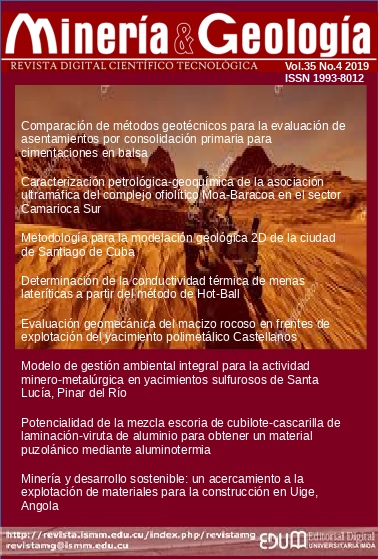Determinación de la conductividad térmica de menas lateríticas a partir del método de Hot-Ball
Palabras clave:
conductividad térmica, menas lateríticas, método Hot-Ball, modelación matemáticaResumen
La conductividad térmica de las menas lateríticas se determinó mediante el método transitorio conocido comúnmente como Hot-Ball. Para ello se construyó una instalación experimental y se aplicó un diseño de experimento que analiza el comportamiento de esta propiedad para tres valores de temperatura. Se obtuvo que la conductividad térmica de la laterita adquiere valores de 1,5 W/(m•K) a 3,5 W/(m•K). Se establece un modelo ajustado con una correlación de 0,98 que estima el valor de la conductividad térmica de las menas lateríticas para los rangos de temperatura de 40 ºC a 70 ºC.Descargas
Citas
Carslaw, H. S. y Jaeger, J. C. 1986: Conduction of heat in solids. 2 ed. U.S.A.: Oxford University Press. 520 p. ISBN-10: 0198533683.
Delgado-Drubey, Y. 2013: Método de balance térmico y de masa para la evaluación del proceso de secado en cilindros rotatorios horizontales. Tesis de maestría. Instituto Superior Minero Metalúrgico de Moa.
Díaz, S. C. 2016: Modelamiento cinético del procesamiento de minerales lateríticos de níquel por vía pirometalúrgica. Tesis doctoral. Universidad Nacional de Colombia-Sede Medellín.
Flores-Cuautle, J. y Lara-Hernández, G. 2017: Thermal Properties of Jojoba Oil Between 20∘C and 45∘C. International Journal of Thermophysics, 38(115). Doi: 10.1007/s10765-017-2252-4.
Hammerschmidt, U. y Sabuga, W. 2000: Transient hot wire (THW) method: uncertainty assessment. International Journal of Thermophysics, 21(6): 1255-1278.
Iguaz, A.; Esnoz, A.; Martı́nez, G.; López, A. y Vırseda, P. 2003: Mathematical modelling and simulation for the drying process of vegetable wholesale by-products in a rotary dryer. Journal of food engineering, 59(2-3), 151-160.
Incropera, F. P.; Lavine, A. S.; Bergman, T. L. y DeWitt, D. P. 2006: Fundamentals of heat and mass transfer. 6th ed. John Wiley & Sons Inc. 1024 p.
Keskinkilic, E.; Pournaderi, S.; Geveci, A. y Topkaya, Y. A. 2016: A Study on the Characterization of Nickel Laterites of Central Anatolia. In: 7th International Symposium on High-Temperature Metallurgical Processing (pp. 403-410). Springer, Cham.
Kouyaté, M.; Flores-Cuautle, J. J. A.; Slenders, E.; Sermeus, J.; Verstraeten, B.; Ramirez, B. G. y Glorieux, C. 2015: Study of Thermophysical properties of silver nanofluids by ISS-HD, Hot Ball and IPPE techniques. International Journal of Thermophysics, 36(10-11): 3211-3221.
Krokida, M.; Marinos-Kouris, D. y Mujumdar, A. S. 2007: Rotary Drying. Handbook of Industrial Dryin. Taylor & Francis: Philadelphia.
Kubicar, L. U.; Vretenár, V.; Stofanik, V. y Bohac, V. 2010: Hot-ball method for measuring thermal conductivity. International Journal of Thermophysics, 31(10): 1904-1918.
Kubicar, L. y Bohac, V. 1999: Review of several dynamic methods of measuring thermophysical parameters. Thermal Conductivity, 24: 135-149.
Ponce, R.; Royo, F. J. y Reynoso, A. G. 2018: Modelo matemático de un secadero rotatorio: secado de biomasa sólida lignocelulósica. Ingeniería Mecánica Tecnología y Desarrollo, 6(2): 031–043.
Retirado, Y.; Góngora, E.; Torres, E. y Rojas, A. L. 2007: Comportamiento de la humedad durante el secado solar del mineral laterítico. Minería y Geología, 23(3): 1-19.
Retirado, Y.; Legrá, A. A.; Lamorú, M.; Torres, E. y Laurencio, H. L. 2012: Optimización del secado solar de la mena laterítica en la industria cubana del níquel. Minería y Geología, 28(2): 30-46.
Silva, M. G.; Lira, T. S.; Arruda, E. B.; Murata, V. V. y Barrozo, M. A. S. 2012: Modelling of fertilizer drying in a rotary dryer: parametric sensitivity analysis. Brazilian Journal of Chemical Engineering, 29(2): 359-369.
Strumillo, C.; Jones, P. y Romuald, Z. 2006: Energy aspects in drying. In: Handbook of Industrial Drying. Second edition. p. 1241-1266. New York: Marcel Dekker. 730 p.
Publicado
Cómo citar
Número
Sección
Derechos de autor 2019 Carlos Zalazar-Oliva, Ever Góngora-Leyva, Yoalbys Retirado-Mediaceja, Andrés Adrian Sánchez-Escalona

Esta obra está bajo una licencia internacional Creative Commons Atribución-NoComercial 4.0.
Los autores que publican en esta revista están de acuerdo con los siguientes términos:
- Licencia Creative Commons Atribución-NoComercial permite que el beneficiario de la licencia tenga el derecho de copiar, distribuir, exhibir y representar la obra y hacer obras derivadas para fines no comerciales siempre y cuando reconozca y cite la obra de la forma especificada por el autor o el licenciante.
- Los autores pueden establecer por separado acuerdos adicionales para la distribución no exclusiva de la versión de la obra publicada en la revista (por ejemplo, situarlo en un repositorio institucional o publicarlo en un libro), con un reconocimiento de su publicación inicial en esta revista.
- Se permite y se anima a los autores a difundir sus trabajos electrónicamente (por ejemplo, en repositorios institucionales o en su propio sitio web) antes y durante el proceso de envío, ya que puede dar lugar a intercambios productivos, así como a una citación más temprana y mayor de los trabajos publicados (Véase The Effect of Open Access) (en inglés).
- Lo anterior debe realizarse siempre sobre el artículo ya publicado por Minería y Geología.
La revista permite que los autores tengan los derechos de autor sin restricciones
La revista permite que los autores conserven los derechos de publicación sin restricciones










